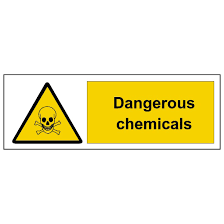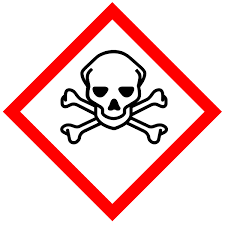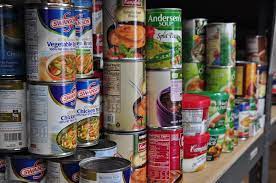How Do Synthetic Chemicals Impact Testosterone Secretion?
How Do Chemicals Hinder Testosterone Production?
Although man's ability to control chemistry and biology has changed how humans live today for the better, there are also numerous negative consequences related to our many decisions. As we produce more industrial chemicals, we are changing the nature of the environment around us.
The Problem with EDCs
Many of these chemicals can alter and impact the function of both human and animal endocrine systems. Scientifically, these chemicals are known as Endocrine-Disrupting Chemicals, abbreviated EDCs. These chemicals can impact many different aspects of hormone production, and some can even affect the sex hormones, causing both males and females to demonstrate certain aspects of the opposite sex.
Endocrine-Disrupting Chemicals are everywhere these days. You likely have dozens of products in your house that contain these ingredients, including  common contraceptives, cleansing agents, and even certain hygiene products such as soaps and shampoos. Many foods contain ingredients that have been proven to impact hormone production. If you aren't careful, they can even contaminate your drinking water.
common contraceptives, cleansing agents, and even certain hygiene products such as soaps and shampoos. Many foods contain ingredients that have been proven to impact hormone production. If you aren't careful, they can even contaminate your drinking water.
Many EDCs Lower Testosterone Levels in Men
Part of maintaining optimal health is recognizing potential risks and minimizing their impact as much as possible. Endocrine-Disrupting Chemicals can significantly impact male health because so many degrade the natural production and function of Testosterone, which can significantly hinder male health over time.
Effect of EDC Pollution on Fish
Here is one powerful example: In Great Britain, researchers have conducted a number of studies regarding the impact of chemical pollution on the rivers and lakes throughout England. Many fish species are susceptible to chemical contamination. In many rivers associated with high pollution levels, the researchers discovered that half of the male fish were producing eggs due to EDC Contamination.
These chemicals entered the waterway primarily via sewage and were having such a tremendous impact on the ecology of the rivers that male fish were starting to transform. Although half of the male fish were producing eggs, the impact on sexual function was even more pronounced. Over three-quarters of these fish impacted by these chemicals exhibited a reduced ability to reproduce.
Endocrine-Disrupting Chemicals can have an Effect on Male Health from Birth.
Without any outside stimulation, sexual development generally occurs during two periods. A certain level of sexual differentiation occurs prenatally: Primary Sex characteristics develop, and there are arguably some differences in psychological development. The period in which boys and girls change sexually and develop secondary sex characteristics is during puberty. Puberty usually occurs a bit earlier in females, but typically, this change occurs between 11-13.
EDCs Can Induce Early Puberty
In recent decades, however, scientists (and parents) have seen many children enter puberty much earlier than usual. One study released in Pediatrics discovered that boys enter puberty between 6 months and 2 years earlier than usual due to the increased incidence of childhood obesity and the increased exposure to chemicals that are triggering puberty.
This means some confident boys and girls enter puberty as early as nine years old! Although this might not seem a significant issue at face value, early puberty can impact psychological and physiological health in countless ways. Early puberty also increases the risk of developing cancers associated with the endocrine system.
Psychological Issues Related to Early Puberty
The combination of puberty and immature psychological development can lead to a number of behavioral and emotional problems, including:
Self-Esteem Issues
Anorexia or Other Eating Disorders
Depression
Increased possibility of Alcohol Exposure
Premature Sexual Activity
Increased Risk of STDs
Prenatal EDC Exposure
Women can also accidentally expose their children to Endocrine-Disrupting Chemicals while in the womb. Exposure to these chemicals during pregnancy can impact male physiological and psychological development before birth.
For example, the male birth rate in Japan and the United States has dropped consistently over the last thirty years, meaning that more fetuses are developing into females than males.
The greater the exposure to these chemicals, the more likely the mother will bear a male child with specific testicular issues. They may develop testicles that are abnormally small, or the testicles may not properly descend fully upon puberty.
These issues, and others, significantly impact testosterone production throughout the lifespan and can also obstruct male fertility. These chemicals can  significantly depress sperm count.
significantly depress sperm count.
Exposure to EDCs has also been linked to an increased risk of Testicular and Prostate Cancer. Males that experience these symptoms are said to suffer from a disorder known as Testicular Dysgenesis Syndrome, which is directly caused by endogenous and exogenous factors that severely depress Testosterone Production.
Phthalate Contamination
One widespread group of Endocrine-Disrupting Chemicals is Phthalates. Overexposure to these chemicals can inhibit normal endocrine function in males, leading to feminization symptoms. These ingredients are ubiquitous in plastics and actively inhibit Testosterone Production while reducing male fertility.
Prenatal exposure to high levels of Phthalates has been strongly correlated with male birth defects. These chemicals seem to cause the male genitals to develop abnormally, causing them to be more feminine in appearance.
What do Phthalates do?
Phthalates disrupt male development and sexual function in a particular way. Studies have shown that pregnant women with DBP and DEHP, two forms of Phthalate, are significantly more likely to give birth to sons that display female characteristics.
Phthalates are in various products we use every day in America, including food packaging, plastic bags, hair sprays, perfumes, anti-antiperspirants, shampoos, soaps, detergents, vinyl flooring, and plastics used in the production of automobiles.
Other Chemicals Which Disrupt Hormone Production
Bisphenol-A (BPA) - This chemical is most commonly found in a number of plastic commodities, such as food cans, reusable bottles, and dental sealants. This chemical can affect prenatal development and increase a woman's breast cancer risk.
Perfluorooctanoic Acid (PFOA) - This chemical agent is used to create surfaces resistant to grease and water. There is also strong evidence that overexposure to this chemical increases the risk of a number of different types of cancer. Many forms of the non-stick pan use this chemical, and the highest levels of exposure likely come from a prevalent source: the inner lining of popcorn bags. It is suspected that popcorn bags contribute to the highest levels of exposure.
Vinclozin (fungicide) and Methoxychlor (insecticide) - Animal studies have shown that these two chemicals can potentially alter the fetal development of rats throughout multiple generations.
Nonylphenol Ethoxylates (NPEs) - These chemicals wreak havoc on the male endocrine system because they have characteristics that cause them to mimic the feminine hormone estrogen. These chemicals also can alter gene expression and the function of certain glands, such as the pituitary.
Bovine Growth Hormone - All animals produce their form of Growth Hormone, and many agricultural firms inject Bovine Growth Hormone into cows to speed up the growth process and produce more meat. Bovine Growth Hormone is also present in many forms of dairy products. The problem is that Bovine Growth Hormone can imitate Estrogen and Human Growth Hormone in some ways, impacting normal hormone production and function.
Non-Fermented Soy Products - Unfermented Soy contains chemicals known as phytoestrogens. Phytoestrogens are plant hormones that share much in common with Estrogen and, in high doses, can function similarly to Estrogen in the human body. In particular, infants should not be fed foods containing soy. One study shows that a child that consumes only soy formula consumes an estrogen level equal to 5 birth control pills. In addition to this, Unfermented Soy also contains proteins that can affect Thyroid Function as well.
Monosodium Glutamate (MSG) - Classically, MSG used to be added to many foods at Chinese Buffets to add flavor and induce fullness. Most people don't realize that today, most Chinese restaurants avoid adding MSG to their foods.
Still, many American restaurants and domestically processed foods contain MSG because they are not so closely scrutinized for MSG. The body creates its own necessary MSG, and the introduction of outside sources can affect natural hormone production.
In addition, the process of creating MSG produces many contaminants, peptide fragments, and amino acids not used by the human body which can hinder proper hormone health. MSG can alter both male and female fertility. In males, excess MSG consumption can drop fertility rates by as much as half. MSG can alter the menstrual cycle in women, making it harder to conceive.
Metalloestrogens - Certain inorganic elements and compounds can mimic estrogen in the human body. Among these are tin, cadmium, lead, mercury, copper, antimony, and aluminum.
Although solid metal forms of most of these Metalloestrogens are perfectly safe (except mercury, lead, cadmium, and other specific Metalloestrogens), incidental ingestion and inhalation of these products can lead to particular issues. They can copy the effects of estrogen while also preventing the proper function of Testosterone.
How to Minimize Exposure to Hormone Disrupting Contaminants
There are many ways to limit your exposure to Endocrine-Disrupting Contaminants. Of course, it will be impossible to safeguard yourself one hundred percent from these compounds, but by being conscientious, you can significantly safeguard yourself and your hormones.
You don't have to walk around in a bubble; you can conveniently change your life.
Avoid Teflon for Your Health
One way to limit exposure to these chemicals is to choose pans that do not contain Teflon or related coatings. We recommend cooking with cast-iron cookware. This cookware is affordable, and when used and maintained correctly, it is just as non-stick as Teflon.
In addition, some companies make Teflon-Alternatives entirely made out of green ingredients that are safe to consume in case they have scraped off accidentally. Ceramic pans are also an excellent choice.
Avoid Canned Foods
Also, when possible, choose dried or fresh vegetables instead of canned vegetables because cans are often sealed using oil-based chemicals, which can impact hormone balance. These chemicals, called Bisphenols, have been shown to affect fertility negatively. Excess Bisphenol exposure directly correlates with decreased Testosterone Production.
Choose Healthy Cleaning Supplies
In addition to this, be conscientious about the cleaning products you use, and always use them in a well-ventilated area, preferably with gloves. Also, seek green alternatives to your products that don't contain a melting pot of potentially unhealthy chemicals. Use natural air fresheners and green or hypo-allergenic fabric softeners and dryer sheets.
Remember that most shower curtains are made of vinyl, and choose curtains that do not contain vinyl compounds. There are a ton of cheap alternatives  if you keep your eyes peeled.
if you keep your eyes peeled.
Choose Organic Hygiene Products
Choose simple soaps and shampoos which only use safe ingredients. There are only a few bare essentials to a quality hygiene product, so there is no reason to choose a product filled to the brim with exotic chemicals.
Regarding your eating habits, limit your intake of processed foods and go for the real thing. In general, organic foods are superior to other forms but remember that even organic foods sometimes contain ingredients that can be harmful.
The best rule of thumb is to buy foods as close to their natural form as possible, and ideally, you should purchase food from trustworthy sellers, whether from a local farmers' market or a reputable company.
Take Control of Your Health and Your Hormones
Knowledge is the first step in safeguarding your health. By limiting your exposure to chemicals that affect your hormone production, you can maintain hormone balance more effectively, which will sustain your long-term health countless times!
- 0001 What Are Normal Testosterone Levels For Men And Women Throughout Life? [Last Updated On: February 14th, 2025] [Originally Added On: May 26th, 2020]
- 0002 Top Tips For Boosting Testosterone Naturally [Last Updated On: September 27th, 2025] [Originally Added On: May 27th, 2020]
- 0003 The Testosterone Factor [Last Updated On: October 28th, 2025] [Originally Added On: May 28th, 2020]
- 0004 Testosterone Can Help Relieve The Menopause Symptom Of Hot Flashes [Last Updated On: February 14th, 2025] [Originally Added On: May 29th, 2020]
- 0005 How Does Low Testosterone Cause Infertility? [Last Updated On: February 8th, 2025] [Originally Added On: May 30th, 2020]
- 0006 The Benefits Of Testosterone Therapy For Prostate Cancer [Last Updated On: February 14th, 2025] [Originally Added On: May 31st, 2020]
- 0007 Is Testosterone Replacement A Valid Diabetes Treatment? [Last Updated On: February 15th, 2025] [Originally Added On: June 1st, 2020]
- 0008 Testosterone Shock Therapy May Be An Effective Prostate Cancer Treatment [Last Updated On: February 5th, 2025] [Originally Added On: June 2nd, 2020]
- 0009 Testosterone Replacement Therapy Is Safe For The Heart [Last Updated On: February 14th, 2025] [Originally Added On: June 3rd, 2020]
- 0010 Testosterone Replacement Therapy [Last Updated On: October 22nd, 2025] [Originally Added On: June 4th, 2020]
- 0011 Testosterone Patches [Last Updated On: February 8th, 2025] [Originally Added On: June 5th, 2020]
- 0012 Testosterone Overview [Last Updated On: February 13th, 2025] [Originally Added On: June 6th, 2020]
- 0013 Testosterone Levels And Making Money [Last Updated On: September 10th, 2025] [Originally Added On: June 7th, 2020]
- 0014 Testosterone Enanthate [Last Updated On: September 9th, 2025] [Originally Added On: June 8th, 2020]
- 0015 Increased Awareness Of Low-t Helps Men Live Healthier Lives [Last Updated On: February 7th, 2025] [Originally Added On: June 9th, 2020]
- 0016 How Does Low-t Lead To Erectile Dysfunction? [Last Updated On: February 7th, 2025] [Originally Added On: June 10th, 2020]
- 0017 Testosterone Basics [Last Updated On: February 6th, 2025] [Originally Added On: June 11th, 2020]
- 0018 How Does Testosterone Impact Prostate Health? [Last Updated On: February 6th, 2025] [Originally Added On: June 12th, 2020]
- 0019 Testosterone And Other Sex Hormones Impact Asthma Response Dependent On Sex [Last Updated On: February 5th, 2025] [Originally Added On: June 13th, 2020]
- 0020 Recognizing Subtle Symptoms Of Testosterone Deficiency [Last Updated On: February 4th, 2025] [Originally Added On: June 15th, 2020]
- 0021 Testosterone Trivia [Last Updated On: February 4th, 2025] [Originally Added On: June 16th, 2020]
- 0022 The Health Benefits Of Testosterone And Sleep Are Interconnected [Last Updated On: February 3rd, 2025] [Originally Added On: June 17th, 2020]
- 0023 How Can I Restore My Testosterone Production Naturally? [Last Updated On: September 4th, 2025] [Originally Added On: June 18th, 2020]
- 0024 Low-t Quiz [Last Updated On: September 3rd, 2025] [Originally Added On: June 19th, 2020]
- 0025 Low Testosterone Might Mean Poor Sleep Need Testosterone Hormone Injections [Last Updated On: September 2nd, 2025] [Originally Added On: June 20th, 2020]
- 0026 Low Testosterone Contributes To Frailty With Age [Last Updated On: September 1st, 2025] [Originally Added On: June 21st, 2020]
- 0027 Low Testosterone Affects A Third Of Young Men With Type 2 Diabetes [Last Updated On: August 31st, 2025] [Originally Added On: June 22nd, 2020]
- 0028 Japanese Testosterone Study Proves Physical And Psychological Benefits [Last Updated On: August 30th, 2025] [Originally Added On: June 23rd, 2020]
- 0029 Intramuscular Injections Are Safer Procedures [Last Updated On: August 29th, 2025] [Originally Added On: June 24th, 2020]
- 0030 Injecting Testosterone (im) [Last Updated On: October 24th, 2025] [Originally Added On: June 25th, 2020]
- 0031 Injectable Testosterone And Testosterone Cream [Last Updated On: February 14th, 2025] [Originally Added On: June 26th, 2020]
- 0032 Indiana Jones Vs. Rambo (hgh Testosterone) [Last Updated On: August 28th, 2025] [Originally Added On: June 27th, 2020]
- 0033 How Much Does Testosterone Control Men's Behavior? [Last Updated On: August 27th, 2025] [Originally Added On: June 28th, 2020]
- 0034 Getting To The Bottom Of Low-t Under-reported Sources Of Testosterone Deficiency [Last Updated On: February 14th, 2025] [Originally Added On: June 29th, 2020]
- 0035 How To Manage And Overcome Testosterone Deficiency [Last Updated On: August 26th, 2025] [Originally Added On: June 30th, 2020]
- 0036 Clomiphene Low-testosterone Andropause Treatment [Last Updated On: February 3rd, 2025] [Originally Added On: July 1st, 2020]
- 0037 Interest In Bio-identical Testosterone Is Skyrocketing [Last Updated On: August 25th, 2025] [Originally Added On: July 3rd, 2020]
- 0038 Axiron Spray-application Testosterone Replacement Therapy [Last Updated On: August 24th, 2025] [Originally Added On: July 4th, 2020]
- 0039 Andropause: Male Menopause [Last Updated On: September 14th, 2025] [Originally Added On: July 5th, 2020]
- 0040 Testosterone Deficiency Treatment Options [Last Updated On: August 21st, 2025] [Originally Added On: July 6th, 2020]
- 0041 The Facts About Testosterone Hrt For Low-t [Last Updated On: August 22nd, 2025] [Originally Added On: July 7th, 2020]
- 0042 Misconceptions About Testosterone Replacement Therapy [Last Updated On: August 23rd, 2025] [Originally Added On: July 8th, 2020]
- 0043 Testosterone Replacement Therapy Facts And Myths [Last Updated On: October 4th, 2025] [Originally Added On: July 9th, 2020]
- 0044 Testosterone Injections For Testosterone Deficiency [Last Updated On: September 18th, 2022] [Originally Added On: July 10th, 2020]
- 0045 Testosterone Replacement Therapy May Help Aging Males Prevent Diabetes [Last Updated On: August 19th, 2025] [Originally Added On: July 11th, 2020]
- 0046 The Benefits Of Testosterone Replacement Therapy For Women [Last Updated On: August 17th, 2025] [Originally Added On: July 13th, 2020]
- 0047 How Can Testosterone Hrt Improve My Life Via Quality Low-t Treatments [Last Updated On: September 13th, 2025] [Originally Added On: July 14th, 2020]
- 0048 Frequently Asked Questions About Testosterone [Last Updated On: August 20th, 2025] [Originally Added On: July 15th, 2020]
- 0049 Bio-identical Testosterone Cypionate Injections [Last Updated On: August 16th, 2025] [Originally Added On: July 16th, 2020]
- 0050 All About Testosterone Creams [Last Updated On: August 13th, 2025] [Originally Added On: July 17th, 2020]
- 0051 Low Testosterone Treatment Protocols [Last Updated On: April 1st, 2025] [Originally Added On: July 19th, 2020]
- 0052 Testosterone Deficiency Drains Your Energy [Last Updated On: February 13th, 2025] [Originally Added On: July 21st, 2020]
- 0053 What Is Testosterone? [Last Updated On: August 11th, 2025] [Originally Added On: July 23rd, 2020]
- 0054 Eleven Signs Of Testosterone Deficiency [Last Updated On: March 30th, 2025] [Originally Added On: July 26th, 2020]
- 0055 Hypertension-Associated Cardiovascular Risks Increase Due To Both Low-T And High Testosterone [Last Updated On: February 18th, 2025] [Originally Added On: April 22nd, 2021]
- 0056 Everything to Know About Androgel [Last Updated On: March 27th, 2025] [Originally Added On: July 8th, 2021]
- 0057 Kinds of Testosterone Therapy – Which Is Right for You? [Last Updated On: March 21st, 2025] [Originally Added On: August 28th, 2021]
- 0058 This Study Says High Protein Diet May Suppress Testosterone Levels [Last Updated On: February 20th, 2025] [Originally Added On: March 28th, 2022]
- 0059 Testosterone and Estrogen Deficiency Associated With Increased Risk of Rotator Cuff Surgery [Last Updated On: February 14th, 2025] [Originally Added On: April 26th, 2022]
- 0060 Low Testosterone Accelerates Aging [Last Updated On: March 20th, 2025] [Originally Added On: May 3rd, 2022]
- 0061 Low Testosterone Endangers Your Health [Last Updated On: February 14th, 2025] [Originally Added On: May 14th, 2022]
- 0062 Testosterone Helps Modulate Immune Activity in the Digestive System [Last Updated On: February 14th, 2025] [Originally Added On: May 18th, 2022]
- 0063 Did you know: Testosterone treats depression! [Last Updated On: November 6th, 2025] [Originally Added On: May 19th, 2022]
- 0064 Benefits of Fenugreek – Boost Testosterone and More [Last Updated On: February 14th, 2025] [Originally Added On: May 23rd, 2022]
- 0065 Testicle Tanning: What is Tucker Carlson Talking About? [Last Updated On: April 16th, 2025] [Originally Added On: June 3rd, 2022]
- 0066 Using Testosterone to Combat Memory Issues in Diabetics [Last Updated On: February 14th, 2025] [Originally Added On: August 16th, 2022]
- 0067 About 40% of Men Have Low-T – and it Doubles the Risk of Severe COVID [Last Updated On: February 25th, 2025] [Originally Added On: September 21st, 2022]
- 0068 The Foods To Boost Your Testosterone…And The Foods To Avoid [Last Updated On: November 4th, 2025] [Originally Added On: September 30th, 2022]
- 0069 Tlando Testosterone: An Innovative Oral Therapy for Low-T [Last Updated On: November 3rd, 2025] [Originally Added On: October 1st, 2022]
- 0070 Testosterone Replacement Therapy (TRT) Explained [Last Updated On: April 8th, 2025] [Originally Added On: October 12th, 2022]
- 0071 Examining The Link Between Testosterone and Employability [Last Updated On: February 18th, 2025] [Originally Added On: November 8th, 2022]
- 0072 Standard Measure of Low Testosterone Doesn't Apply to Young Men [Last Updated On: March 12th, 2025] [Originally Added On: November 8th, 2022]
- 0073 Surprising Things that Cause Men’s Crashing Testosterone [Last Updated On: March 17th, 2025] [Originally Added On: January 5th, 2023]
- 0074 Understanding the Correlation between Testosterone Levels and Job Performance [Last Updated On: February 9th, 2025] [Originally Added On: February 9th, 2025]
- 0075 Link between Low Testosterone and Severe COVID Symptoms in Men [Last Updated On: February 12th, 2025] [Originally Added On: February 12th, 2025]
- 0076 The Good Job Grip: Is Testosterone the Key? [Last Updated On: February 13th, 2025] [Originally Added On: February 13th, 2025]
- 0077 Importance of Nutritional Balance in a Healthy Diet [Last Updated On: February 14th, 2025] [Originally Added On: February 14th, 2025]
- 0078 Invigorating Power of the Fenugreek Plant: A Natural Testosterone Energizer and More [Last Updated On: February 14th, 2025] [Originally Added On: February 14th, 2025]
- 0079 Unlocking the Testosterone Treasure: A Panacea for Cognitive Woes in Diabetic Patients [Last Updated On: February 14th, 2025] [Originally Added On: February 14th, 2025]
Word Count: 1883






